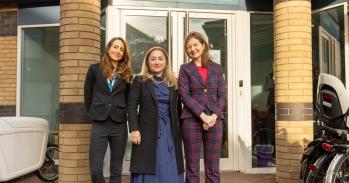
The new COSMOS@DiRAC supercomputer will advance our understanding of the origin and structure of our universe.
The new COSMOS@DiRAC supercomputer will advance our understanding of the origin and structure of our universe.
Cosmology is now a precision science, so we need machines like COSMOS to reach out and touch the real universe, to investigate whether our mathematical models are correct.
Professor Stephen Hawking
Professor Stephen Hawking has launched the most powerful shared-memory supercomputer in Europe. Professor Hawking anticipates that the COSMOS supercomputer, manufactured by SGI and the first system of its kind, will open up new windows on our Universe.
During the launch, which is part of the Numerical Cosmology 2012 workshop at the Centre for Mathematical Sciences at the University of Cambridge, Professor Hawking said: “We have made spectacular advances in cosmology and particle physics recently. Cosmology is now a precision science, so we need machines like COSMOS to reach out and touch the real universe, to investigate whether our mathematical models are correct.”
The COSMOS supercomputer is part of the Science and Technology Facilities Council DiRAC High Performance Computing facility, a national service for UK cosmologists, astronomers and particle physicists, as well as non-academic users.
The Numerical Cosmology 2012 workshop, supported by Intel, has drawn together leaders in computational cosmology with technological innovators. Professor Peter Haynes, head of the Department of Applied Mathematics and Theoretical Physics at the University of Cambridge, said: “We are excited that such a diverse group of participants could make it – people who normally do not attend the same conferences – and the aim is to have a genuine cross-fertilisation of emerging applications and technologies”.
Professor Hawking added: “I hope that we will soon find an ultimate theory which, in principle, would enable us to predict everything in the Universe. However, participants at this workshop will be pleased to learn that this will not end our quest for a complete understanding. Even if we do find the ultimate theory, we will still need supercomputers to describe how something as big and complex as the Universe evolves, let alone why humans behave the way they do!”
The COSMOS consortium's current programme of research aims to advance our understanding of the origin and structure of our universe, primarily through the scientific exploitation of the cosmic microwave sky.
Dr Jeremy Yates, the Project Director for DiRAC, said: "The COSMOS supercomputer is an essential and vital part of the DiRAC Facility. DiRAC now offers five leading systems to UK researchers, two of which are in Cambridge. It allows the UK cosmology and extra-solar planet research communities to take a leading role in understanding how structure was formed in the very early Universe and the composition of the atmospheres of extra-solar planets. These activities will deepen our understanding of the origins of the cosmos and life, and make a vital contribution to the knowledge economy."
“This flexible shared-memory system will enhance researcher’s capabilities at institutions across the UK and will ensure they remain at the forefront of cosmological research internationally,” concluded Professor Paul Shellard, Director of the Centre for Theoretical Cosmology.
This work is licensed under a Creative Commons Licence. If you use this content on your site please link back to this page.





